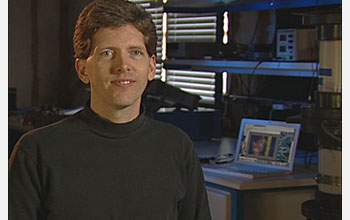
Press Release 08-041 - Video
Dan Schlitz of Thorrn Micro Technologies, Inc., Describes Innovative Micro-fan Technology.

 |
 View Video View Video |
Dan Schlitz of Thorrn Micro Technologies, Inc., describes innovative micro-fan technology.
Credit: NSF and Thorrn Micro Technologies, Inc. Back to article |
Video Transcript:
What we've invented here is an ultra thin fan that blows air without any moving parts. The uniqueness of the device is that it is ultra thin, ah, very small and blows air and dissipates heat without any moving parts. It is very small and compact for use in handheld electronics like laptop computers and other small devices. When we have tiny electrodes with small gaps in the air, and the electrodes actually ionize the air. In certain places those ions move across the air gap and along the way they transfer momentum to the air and that creates the blowing action. Some electronics tend to run hot and require cooling. Other electronics, because you can't put a cooling on them, they have to limit their capabilities. So this will open up designers to be able to put more functioning, higher functioning processors in places they would not be permitted to because of cooling issues. Cooling electronics is a growing concern as the CPUs and processors get more powerful, they dissipate more heat. Moving that heat has become a greater and greater challenge and is what interested me in this problem. The cost target is to be comparable with the conventional cooling systems. The research for the device is more or less complete, It's ready to go, ready to be designed into a product. The technology could be in a product by 2009. 
This video requires the free Flash Player plug-in
|



